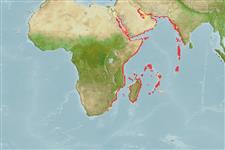Teleostei (teleosts) >
Eupercaria/misc (Various families in series Eupercaria) >
Sparidae (Porgies)
Etymology: Argyrops: Greek, argyros = silver, silvered + Gree, ops = appearance (Ref. 45335).
More on author: Valenciennes.
Environment: milieu / climate zone / depth range / distribution range
Ecology
Marine; reef-associated; depth range 50 - 200 m (Ref. 124569). Tropical
Western Indian Ocean: east coast of Africa (South Africa and Mozambique), Mauritius,
Madagascar, and Réunion.
Length at first maturity / Size / Weight / Age
Maturity: Lm 22.2, range 16 - ? cm
Max length : 70.0 cm TL male/unsexed; (Ref. 3198); common length : 40.0 cm TL male/unsexed; (Ref. 3507)
Dorsal spines (total): 12; Dorsal soft rays (total): 10; Anal spines: 3; Anal soft rays: 8; Vertebrae: 24. This species is distinguished from all its congeners by the following set of characters: body deep and becoming compressed and slender with growth; D XII,10; the first 2 dorsal-fin spines rudimentary (2 dorsal-fin spines on first dorsal pterygiophore), third dorsal-fin spine longest (1.3-1.6, mean 1.4, in 3DFS/4DFS), thirrd not reaching beyond level of origin of first soft dorsal-fin ray and not greater than head length; orbit diameter subequal to suborbital depth. Colouration: body uniform pink, silvery belly and chin; spinous dorsal fin yellowish pink, other fins are yellowish pink or pale pink; cheek and region above the eye with bluish tinge; upper jaw often with yellowish orange tinge (Ref. 124569).
Found over corals in warmer waters and rocky reefs over sandy bottoms; feeds on benthic invertebrates (Ref. 5213, 124569). Sold fresh, whole or dried in markets (Ref. 3507).
Iwatsuki, Y. and P.C. Heemstra, 2018. Taxonomic review of the genus Argyrops (Perciformes; Sparidae) with three new species from the Indo-West Pacific. Zootaxa 4438(3):401-442. (Ref. 124569)
IUCN Red List Status (Ref. 130435: Version 2024-1)
Threat to humans
Harmless
Human uses
Fisheries: minor commercial
Tools
Special reports
Download XML
Internet sources
Estimates based on models
Preferred temperature (Ref.
123201): 24.7 - 29.2, mean 27.1 °C (based on 236 cells).
Phylogenetic diversity index (Ref.
82804): PD
50 = 0.5625 [Uniqueness, from 0.5 = low to 2.0 = high].
Bayesian length-weight: a=0.02089 (0.00983 - 0.04439), b=2.96 (2.78 - 3.14), in cm total length, based on LWR estimates for this (Sub)family-body shape (Ref.
93245).
Trophic level (Ref.
69278): 3.5 ±0.37 se; based on food items.
Generation time: 4.8 ( na - na) years. Estimated as median ln(3)/K based on 1
growth studies.
Resilience (Ref.
120179): Medium, minimum population doubling time 1.4 - 4.4 years (K=0.227; tmax=10; tm=2; Fec = 73,363).
Fishing Vulnerability (Ref.
59153): Moderate vulnerability (40 of 100).
